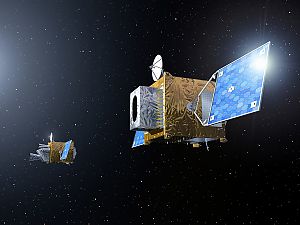Europe's Mars mission with technology from Austria

In the coming year, many space missions will use high technology from Austria. "The most spectacular space mission with red-white-red participation in 2022 is probably Europe's mission to Mars," says Andreas Buhl, Managing Director of RUAG Space Austria, Austria's largest space company. In September, a Mars robot is to be launched into space. The landing on Mars is planned for June 2023. "This will be the first time red-white-red hardware will land on the red planet," Buhl emphasises. RUAG Space Austria gives the Mars rover foresight and built the mast for the Mars rover's "eyes". The camera mast, which is more than one metre long, is made of carbon fibre and was developed and produced in Vienna. Mechanisms ensure that the mast is held down during take-off and landing, that it is unfolded after landing and that the instruments attached to the top can be adjusted. For the computer ("brain") of the rover, electronics for the power supply were produced in Vienna. (The NASA Mars robot Perseverance used software by Austrian scientists, but no technology from RUAG Space Austria).
Heat protection for new European rocket
In the course of the new year, the new European rocket Ariane 6 is to be launched into space for the first time. RUAG Space Austria produced the high-temperature thermal insulation for the launcher's rocket engines. "The premiere flight will be an absolute test for our insulation. On the journey from Earth into space, the rocket engines protected by our insulation will have to withstand extreme heat of up to 1,500 degrees Celsius for a few minutes. That is a temperature where iron begins to melt," says Buhl. The high-temperature insulation for launch vehicles consists of glass and ceramics and was manufactured in Berndorf. The new European rocket Ariane 6 is being built by ArianeGroup on behalf of the European Space Agency ESA.

Camera cover for weather satellites
In the fourth quarter of 2022, the first European Meteosat weather satellites of the third generation are to be launched into space from the European spaceport in Kourou, French Guiana. The Vienna-based space company is developing and building a range of different electronic units and mechanisms for the total of six satellites in the new series. RUAG Space Austria supplied the mechanism's electronic motor control system. In addition, the company produced a mechanism for one of the optical instruments on board the satellite. For one of the other instruments, a high-precision spectrometer, RUAG Space Austria supplied a reclosable, lightproof cover, a kind of "camera cover". For this purpose, a motorised drive for the cover is being designed and built so that the two flaps can be moved independently of each other.
Satellite containers and heat protection for telecom satellites
In the course of the coming year, there will be further regular launches of more than 30 small satellites each from the British-Indian telecommunications company OneWeb. Currently, 358 satellites are in space. In future, a total of 650 OneWeb satellites will be operating in space. The telecom satellites bring internet to remote regions of the world. RUAG Space supplied customised container solutions for transporting the satellites to the worldwide rocket launch centres. RUAG Space also equipped the washing machine-sized satellites with heat protection. The special thermal insulation protects the several hundred satellites from extreme cold and heat in space of plus/minus 150 degrees Celsius. The thermal insulation was manufactured in Berndorf, Lower Austria, and consists of several layers of metallised polyester and polyimide films.
